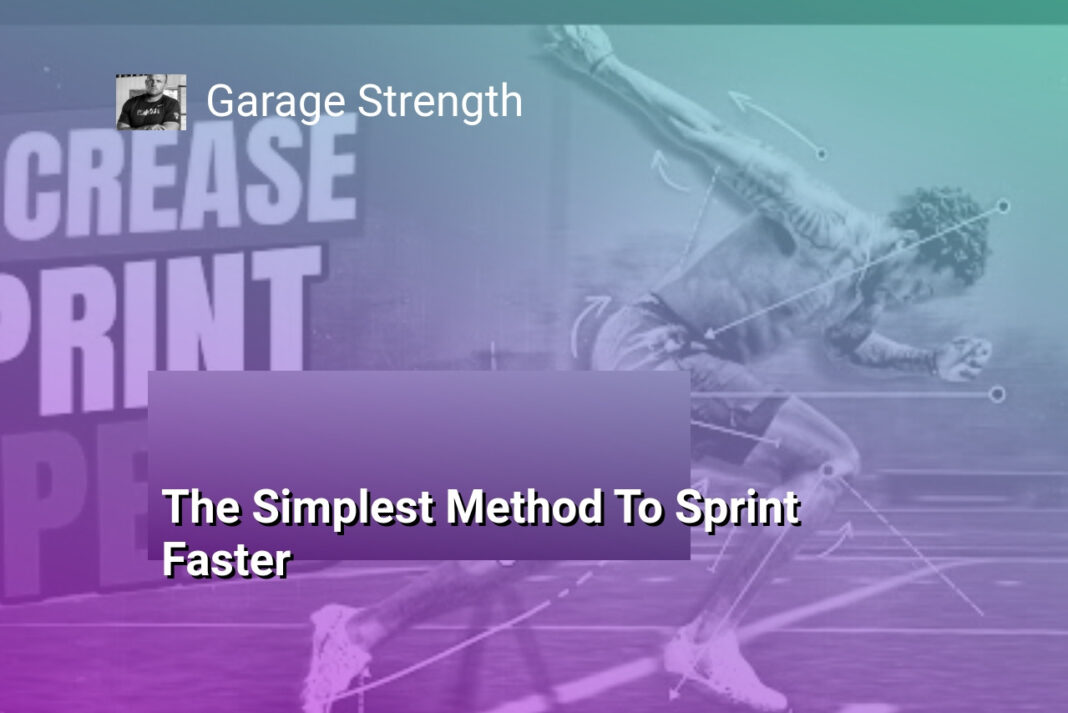The Bottom Line:
- The main focus of the text is on improving running mechanics and technique to enhance speed and efficiency, particularly at maximum velocity.
- The expert, Michael, emphasizes the importance of proper body alignment, hip position, and knee drive to optimize force application and ground contact time.
- Michael explains the common issue of “butt kick” or early foot striking in front of the body’s center of mass, which can lead to inefficient force transfer and increased braking forces.
- To address this, Michael suggests getting the athlete more upright, with a neutral hip position, and focusing on actively lifting the knee and whipping the hip to create a shorter ground contact time and better force application.
- The expert emphasizes that this change in mechanics may initially feel awkward for the athlete, but it is a necessary learning process to develop a more efficient and powerful running technique.
Assessing Mechanics: The Foundation for Speed
Optimizing Foot Placement: The Key to Efficient Force Application
One of the foundational elements in achieving max velocity is the proper mechanics of foot placement and ground contact. As a speed specialist, I emphasize the importance of assessing and refining this crucial aspect of an athlete’s running technique.
Identifying Inefficient Foot Strike Patterns
When an athlete first comes to me, I often observe a common issue – a “stuck in fourth gear” posture, where the hips are tilted forward, the knees don’t lift high enough, and the foot strikes the ground in front of the body’s center of mass. This foot strike pattern can lead to a “butt kick” effect, where the heel actually hits the glutes, and the foot lands in a way that acts as a brake, slowing the athlete down.
Transitioning to a More Upright Posture
To address this, I guide the athlete to adopt a more upright posture, with the hips in a more neutral position. This allows for greater knee lift and creates the necessary space between the foot and the ground. By consciously lifting the knee and “whipping” the hip forward, the athlete can learn to strike the ground closer to their center of mass, generating more efficient and powerful force application.
The adaptation to this new movement pattern can take time, often ranging from 2-4 weeks or even longer for some athletes. During this transition, the athlete may initially experience a slight decrease in top-end speed, but the long-term benefits of this mechanical adjustment are invaluable. By optimizing the force profile of the foot contact, we can harness the power of the Achilles tendon and other elastic structures, allowing the athlete to spring off the ground more efficiently and effectively.
The key is to embrace the discomfort of this change and trust the process. By focusing on these foundational mechanics, we can lay the groundwork for unlocking the athlete’s true max velocity potential.
The Science of Force, Ground Contact, and Direction
Harnessing the Power of Ground Contact and Direction
The key to unlocking max velocity lies in understanding the science behind force, ground contact, and the direction of movement. As a speed specialist, I emphasize these fundamental principles to help athletes optimize their running mechanics and achieve their full potential.
The Role of Force
Force is the driving force behind forward motion. I teach athletes to visualize three distinct forces: force moving forward, force moving backward, and force moving vertically. By recognizing and harnessing these forces, athletes can learn to generate and apply them effectively during their sprinting technique.
Mastering Ground Contact Time
Ground contact time, or the duration the foot remains in contact with the ground, is a crucial factor in speed development. The goal is to minimize ground contact time while maximizing the force applied during that brief moment. I guide athletes to understand the importance of a quick, efficient foot strike that allows the Achilles tendon to act as a spring, propelling them forward with greater power.
Optimizing Direction of Force
The direction of the applied force is just as important as the magnitude. I emphasize the need for athletes to strike the ground in a way that aligns the force vector with the desired direction of movement. This often requires adjustments to the athlete’s posture and hip positioning, allowing them to maintain an upright, neutral position and generate force that drives them forward rather than vertically or backward.
By addressing these three key elements – force, ground contact, and direction – I help athletes transform their running mechanics and unlock their true speed potential. Through targeted drills and cues, they learn to harness the science of movement, ultimately translating into faster times and more efficient, powerful sprinting.
Mastering Upright Posture and Hip Mobility
Enhancing Upright Posture and Hip Mobility
To address the common issue of an “in-stuck and fourth gear” posture, we’ll focus on improving your upright posture and hip mobility. This will allow you to generate force more efficiently and direct it in the right direction for maximum velocity.
Achieving Neutral Hip Alignment
First, we’ll work on getting your hips into a more neutral position. Instead of the typical bent-over, angled hip position, we want to achieve a more upright stance. This will create space between your foot and the ground, enabling your knee to drive up higher. As you tilt your pelvis to a neutral position, you may feel a stretch in your hamstrings, which is a good sign that we’re on the right track.
Mastering the Hip Whip
The key to this upright posture is learning to “whip” the hip. When your foot leaves the ground, focus on actively driving your hip forward and down, allowing your thigh to swing back and your foot to strike the ground closer to your center of mass. This “negative thigh speed” is crucial for generating efficient ground contact and maximizing your vertical force application.
As you practice this hip whip, you’ll notice a significant change in your foot strike pattern. Instead of landing out in front of your body and acting as a brake, your foot will now make contact closer to your center, allowing you to drive powerfully through the ground. This shift in force application will make your running mechanics much more efficient, even if your initial top-end speed takes a slight dip during the transition period.
Remember, this new movement pattern will feel extremely awkward at first, but embracing the discomfort is essential for developing this critical skill. With consistent practice and patience, your body will adapt, and you’ll begin to reap the benefits of this more upright, hip-driven running mechanics.
Harnessing the Power of the Achilles Tendon
Harnessing the Achilles Tendon’s Elastic Potential
The Achilles tendon is a crucial component in the biomechanics of sprinting. By optimizing its function, we can unlock significant gains in running speed and efficiency. One of the key principles I teach my athletes is the importance of utilizing the Achilles tendon’s elastic properties to their full advantage.
Maximizing Tendon Elasticity
The Achilles tendon acts as a powerful spring, storing and releasing energy with each stride. When the foot strikes the ground, the Achilles tendon is stretched, storing energy. As the foot leaves the ground, this energy is released, propelling the athlete forward. By coaching athletes to maintain an upright posture and optimize their foot strike, we can ensure that the Achilles tendon is engaged and contributing to the force production during the running motion.
Developing Achilles Tendon Strength and Stiffness
In addition to proper running mechanics, we also focus on building Achilles tendon strength and stiffness through targeted exercises. Plyometric drills, eccentric loading, and resistance training can all help to enhance the tendon’s ability to store and release energy efficiently. By developing a stiffer, more responsive Achilles tendon, athletes can generate greater force production and experience a more explosive take-off with each stride.
The key to harnessing the power of the Achilles tendon lies in the integration of both technical and physical training. By coaching proper running mechanics and implementing targeted strength and conditioning protocols, we can help athletes unlock the full potential of this critical structure, leading to significant improvements in speed, acceleration, and overall running performance.
Drills for Developing Efficient Foot Strike
Optimizing Foot Strike: Drills for Efficient Mechanics
To address the inefficient foot strike pattern, we’ll focus on a series of drills that help develop the desired mechanics. These exercises aim to promote a more upright posture, increase knee lift, and encourage a foot strike closer to the body’s center of mass.
Wall Drills for Upright Posture
The first step is to get the athlete in an upright, neutral hip position. We’ll start with wall drills to reinforce this posture. The athlete will stand with their back against the wall, maintaining a tall, upright stance without arching the lower back. From this position, they’ll focus on lifting the knees, ensuring there is space between the foot and the ground. The key cue is to have the heel step over the knee, rather than the foot reaching out in front.
Knee Lift Exercises
Next, we’ll progress to exercises that specifically target knee lift. One effective drill is the “High Knee March.” In this exercise, the athlete will march in place, emphasizing a high knee lift and a quick, snappy foot strike. The goal is to achieve a knee height that allows for a foot strike closer to the body’s center of mass. This drill helps develop the hip flexor strength and coordination required for efficient running mechanics.
Foot Strike Drills
To further refine the foot strike pattern, we’ll incorporate drills that focus on the timing and placement of the foot. One such exercise is the “Foot Strike Tap.” The athlete will stand in an upright position and practice tapping the ground with the foot, concentrating on a quick, light contact and a foot strike directly under the body’s center of mass. This drill helps reinforce the desired foot strike pattern and promotes a more efficient force application.
By incorporating these drills into the training program, the athlete will gradually develop the necessary neuromuscular patterns and muscle memory to achieve a more efficient foot strike. The goal is to create a smooth, powerful, and economical running gait that maximizes velocity and minimizes energy expenditure.





